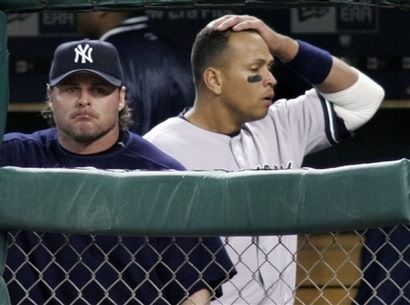 The Red Sox have long had a reputation for wearing down opposing pitchers. Their game plan is to drive up the opposing pitcher's pitch count early. That way the Red Sox can face the soft underbelly of pitching staffs - the middle relief. And this strategy is often effective, especially when facing the top members of a team's rotation.
The Red Sox have long had a reputation for wearing down opposing pitchers. Their game plan is to drive up the opposing pitcher's pitch count early. That way the Red Sox can face the soft underbelly of pitching staffs - the middle relief. And this strategy is often effective, especially when facing the top members of a team's rotation.But just how effective are the Red Sox at this strategy? Well, with the exception of Dustin Pedroia, every member of 2007's Opening Day Red Sox lineup was among the top 50 American League hitters in pitches per plate appearance. The nine members of 2008's starting lineup averaged 3.94 pitches per plate appearance last year. Here's how that breaks down.
Ellsbury - 3.67 PPA
Pedroia - 3.80 PPA
Ortiz - 4.10 PPA
Ramirez - 3.86 PPA (career average of 4.03)
Lowell - 3.80 PPA
Drew - 3.93 PPA
Youkilis - 4.27 PPA (career average of 4.40)
Varitek - 4.12 PPA
Lugo - 3.88 PPA
Pedroia - 3.80 PPA
Ortiz - 4.10 PPA
Ramirez - 3.86 PPA (career average of 4.03)
Lowell - 3.80 PPA
Drew - 3.93 PPA
Youkilis - 4.27 PPA (career average of 4.40)
Varitek - 4.12 PPA
Lugo - 3.88 PPA
So how does that patience affect pitchers? At that rate, it would take about 25 plate appearances to drive up the opponent's pitch count to 100. And how long did it take the Red Sox to get 25 plate appearances in a typical game? Well, I'm pretty sure there isn't a figure available for that, so I'll attempt to get an estimate.
Red Sox hitters had 6,426 plate appearances last year. Opponent pitchers logged 1,422.2 innings against the Red Sox. So that means the average offensive Red Sox inning had about 4.52 plate appearances. And so it took about 5.53 innings for the Red Sox to drive up a starter's pitch count to the magic mark of 100.
And unlike other teams that drive up the pitch counts of bad pitching, the Red Sox wore out some of the American League's biggest workhorses. Royal Halladay, who averaged 7.27 innings per start, averaged just 6.66 innings against the Red Sox. Chien-Ming Wang, who averaged 6.64 innings a start, averaged just 6.14 against the Red Sox. And Andy Pettitte, who averaged 6.27 innings per start, averaged just 5.55 innings against the Red Sox.
Red Sox hitters had 6,426 plate appearances last year. Opponent pitchers logged 1,422.2 innings against the Red Sox. So that means the average offensive Red Sox inning had about 4.52 plate appearances. And so it took about 5.53 innings for the Red Sox to drive up a starter's pitch count to the magic mark of 100.
And unlike other teams that drive up the pitch counts of bad pitching, the Red Sox wore out some of the American League's biggest workhorses. Royal Halladay, who averaged 7.27 innings per start, averaged just 6.66 innings against the Red Sox. Chien-Ming Wang, who averaged 6.64 innings a start, averaged just 6.14 against the Red Sox. And Andy Pettitte, who averaged 6.27 innings per start, averaged just 5.55 innings against the Red Sox.













